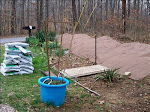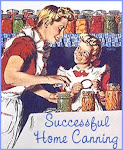I’m dying to try whatever new and experimental gardening method comes out. I have raised French intensive garden beds, a cinder-block composter, a drip water system, companion plantings, cold frames...you name it. Recently I got on a straw-bale garden kick. The pictures look great, the gardens produce, and it wouldn’t take much of an investment. But suddenly I found myself visualizing the work involved in getting the bales ready, the intensive watering required, and I realized I’m not ready to add to my existing collection of garden beds—I’m not even taking care of the ones I have!
So today I re-sketched the front and back yards and all the different gardening areas. It’s easy to see from the drawings where the weak points are. I do these sketches in pencil so I can erase and rename areas that change and are added to.
Following the paperwork phase of taking care of the yardens, I
spent two hours weeding and grubbing onions,
spread a cup of blood meal each on the compost heaps and watered in,
fed the seedlings, indoors and out,
and mowed around the raised bed gardens.
Small chores, true, but necessary to the health of the garden, the compost heap, and the neighbors’ happiness. My gardens will reflect the level of attention and care they’ve received from me. I learned that it’s more fun to start a new project than continue with an old one, but that continuation is what brings about good results.
Wednesday, March 31, 2010
Tuesday, March 2, 2010
Where Do I Start?
This year you want to make a garden. You’ve tried before with little success, and you’ve decided to make it happen this year. But there’s all this ground in your yard and you don’t know how to start. Where do you begin? My best advice to new gardener’s is to use raised-bed gardening. It helps cut down on weeding and provides an instantly wonderful growing medium for your plants.
Now is the time to build your garden. Here is my list of steps to help you get started this year. No tools needed.
Materials Needed:
16 cinder blocks
Newspapers
One bag manure
One bag sand
One bag peat
Six bags of top soil
Find a spot that gets sunlight for at least eight hours a day. No shade trees nearby, no other plants growing around the area that might pollute your food garden.
Lay the cinder blocks out in a square or rectangle.
Line the bottom of the square with thick, thick layers of newspaper. Be sure to line under the cinder blocks to keep weeds from growing out of the holes in the blocks.
If you have raw compost, spread a layer over the newspaper.
Pour three bags of dirt over that layer.
Add a layer of leaves if you have them.
Pour the sand, peat moss and manure next.
Top with the remaining top soil. Add top soil into the holes in the cinder blocks.
Congratulations, you’ve built a raised-bed garden. Think of it as a large flower pot where you will be growing your veggies.
PLANTING
Beets
Carrots
Romaine
Spinach
Sweet Pepper
Cabbage
Onions
Chard
You choose the seeds according to when you’ll be planting. For a good planting guide, go to http://www.almanac.com/gardening/planting-dates/zipcode/38401. Choose your planting dates according to where you live.
Remember when you plant, slightly water the soil first, and then put the seed in the prepped soil. You only want to plant as deep as the seed is large. For myself, when I plant a new bed outdoors, I cover it with landscape cloth to keep the cats from digging in the soil. That also allows me to plant early.
These plants need their own beds or prepped areas away from your raised-bed garden:
Zucchini, Eggplant and other squashes
Tomatoes
Cukes
Pumpkins
Some herbs
Look around your yard for other planting spots. Do you have a fence or trellis that gets lots of straight sun every day? Perfect place to plant peas. Peas are very forgiving, they are easy to grow and harvest. Mine grow up the trellis on the deck and on the fence in the courtyard.
Tomatoes need a huge growing area. You can see from the photo of my September tomatoes that by fall you’ll have your hands full. I grow mine on hills along the fence next to each other.
HERBS
You can plant herbs with your other foods. Stay tuned for more information about planting herbs.
Subscribe to:
Comments (Atom)





















